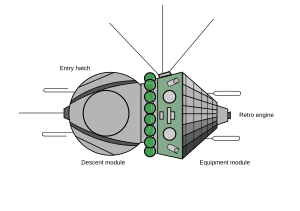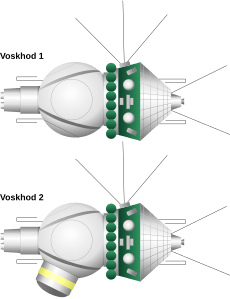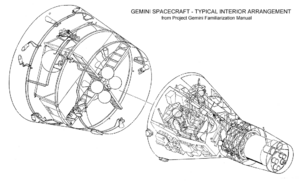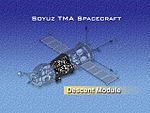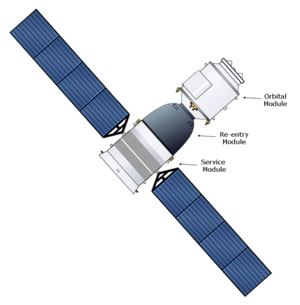Space capsule facts for kids
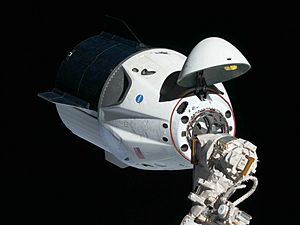
A space capsule is a special kind of spacecraft built to carry things like cargo, science experiments, or even astronauts into space and back. What makes a capsule different from other spacecraft is its ability to safely return to Earth. They are usually blunt (rounded) in shape and don't have wings. They also carry only a small amount of fuel, just enough for a safe trip home.
Many spacecraft that carry people, like the Soyuz or Orion, are capsules. They often have extra parts, like a service module, that help them work in space. While most crewed spacecraft are capsules, there has been one crewed spaceplane, the Space Shuttle, that flew in orbit.
Today, space capsules that carry people include the Soyuz, Shenzhou, and Dragon 2. New capsules being built for future missions are NASA's Orion, Boeing's Starliner, Russia's Orel, India's Gaganyaan, and China's Mengzhou.
In the past, famous crewed capsules included Vostok, Mercury, Voskhod, Gemini, and Apollo. A space capsule carrying people must keep them safe and alive in the harsh environment of space, which has extreme temperatures and radiation. Some capsules, like Soyuz, are used only once (expendable). Others, like Crew Dragon, can be used many times (reusable).
Contents
History of Space Capsules
Vostok: First in Space
The Vostok was the Soviet Union's very first space capsule designed to carry a person. The first ever human spaceflight happened on April 12, 1961, when cosmonaut Yuri Gagarin flew in Vostok 1.
The Vostok capsule was first designed to be a spy satellite, but it was also used for crewed flights. This helped get support for the program. The capsule had a round part for returning to Earth and another part with engines and supplies. This basic design was used for about 40 years, even for other uncrewed satellites.
The Vostok was a single-seat capsule. It was about 4.4 meters (14.4 feet) long and 2.4 meters (7.9 feet) wide. It weighed about 4.73 tonnes (10,430 pounds) at launch. The part that returned to Earth was covered in a special heat shield. The cosmonaut sat in an ejection seat. This seat had its own parachute, so the cosmonaut could escape if there was an emergency during launch or land safely during a normal flight. The capsule also had its own parachute for landing.
Even though official reports said Gagarin landed inside his capsule, it was later known that all Vostok cosmonauts ejected and landed separately. The capsule also had a section at the back with oxygen, batteries, fuel, and a rocket to slow it down for return. It could support flights for up to ten days. Six Vostok flights were successful. The longest flight was almost five days, on Vostok 5 in June 1963.
Because the Vostok capsule couldn't steer itself much during reentry, it had to be protected from heat on all sides. This is why it was designed as a sphere (a ball shape). When the capsule came back into Earth's atmosphere, the air around it got so hot that it created a layer of plasma. This plasma blocked radio communication with the ground.
Voskhod: More Cosmonauts
The Vostok design was changed to allow more than one cosmonaut to fly. These modified capsules were used for two flights in the Voskhod programme. The inside of the capsule was made wider to fit either three cosmonauts sitting side-by-side (Voskhod 1) or two cosmonauts with an inflatable airlock between them (Voskhod 2). The airlock was needed for extravehicular activity (spacewalks). A backup rocket was added to help with landing.
To save space, the ejection seat from the Vostok was removed. This meant the crew had no way to escape if there was a problem during launch or landing. The Voskhod spacecraft weighed about 5682 kg (12,527 pounds).
On Voskhod 1, the crew did not wear space suits because there wasn't enough room. However, both crew members on Voskhod 2 wore spacesuits because one of them, Alexei Leonov, performed a spacewalk. An airlock was needed for the spacewalk because the spacecraft's systems were cooled by air. If the capsule lost all its air, it would overheat. The airlock was thrown away after it was used.
Since there were no ejection seats, the Voskhod crew landed inside their spacecraft. A new landing system was created. It added a small rocket to the parachute lines. This rocket fired just before landing, making the touchdown softer.
Mercury: America's First Steps
The Mercury program was the United States' first program to send a person into space. It ran from 1958 to 1963. Its main goal was to put a human in orbit around Earth and bring them back safely. The program used a small capsule launched by a rocket.
The Mercury capsule was about 10.8 feet (3.3 meters) long and 6.0 feet (1.8 meters) wide. With the launch escape system, it was about 25.9 feet (7.9 meters) long. The inside was just big enough for one astronaut. It had 120 controls, including switches and levers. The heaviest Mercury spacecraft weighed about 3000 pounds (1360 kg). Its outer skin was made of a special metal that could handle very high temperatures.
The spacecraft was shaped like a cone. It had a rounded base with a heat shield. This heat shield protected the capsule from the extreme heat during reentry. Attached to the heat shield were three small rockets that helped slow the spacecraft down. The main part of the capsule was the pressurized area where the astronaut sat. Below the seat was the system that provided oxygen and heat, and cleaned the air. At the narrow end of the spacecraft were three parachutes: a small one to stabilize it and two main ones for landing.
A special launch escape system was on top of the capsule. It had three small rockets that could quickly pull the capsule away from the main rocket if there was a problem during launch. This would deploy the capsule's parachute for a safe landing in the ocean nearby.
The Mercury spacecraft did not have its own computer. All the calculations for reentry were done by powerful computers on the ground at NASA facilities. The results were then sent to the spacecraft by radio.
The US launched its first Mercury astronaut, Alan Shepard, on a short suborbital flight in May 1961. This was almost a month after the Soviets sent the first human into orbit. The US finally orbited its first American, John Glenn, on February 20, 1962. The United States launched a total of two crewed suborbital Mercury capsules and four crewed orbital capsules. The longest flight, Mercury-Atlas 9, orbited Earth 22 times and lasted 32 and a half hours.
Gemini: Preparing for the Moon
The Gemini spacecraft was a very important step before the Apollo program, which aimed to land humans on the Moon. Gemini was designed to test new ways to meet up and connect with other spacecraft in orbit. It also had better life support systems and improved ways for the spacecraft to return to Earth.
Unlike Mercury, Gemini used modern electronic parts. Its design was modular, meaning it was made of different parts that were easy to fix.
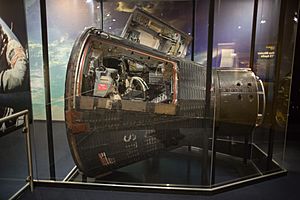
Gemini's emergency escape system was different from Mercury's. It did not use a tall escape tower with a rocket. Instead, it used ejection seats, like those in fighter jets. Engineers thought these seats would be enough to get astronauts away from a faulty rocket because the Titan II rocket's fuel would burn quickly without a huge explosion. However, these ejection seats could only be used for about 40 seconds after liftoff. After that, the rocket would be going too fast.
A big concern was that the ejection seats might hurt the astronauts. Also, if they ejected during flight, they would go through the rocket's exhaust. Luckily, the Gemini ejection system was never needed in an emergency.
The Gemini spacecraft was the first to have an onboard computer. This computer, called the Gemini Guidance Computer, helped manage and control the mission. It weighed about 58.98 pounds (26.75 kg). It had a memory that could store 4096 "words" of information.
Apollo: To the Moon and Beyond
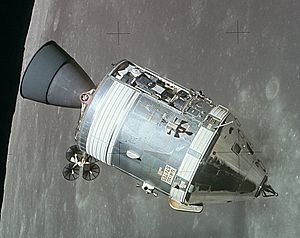
The Apollo spacecraft was first thought of in 1960. It was designed to carry three people and follow the Mercury program. Its goals included taking astronauts to a space station, flying around the Moon, or even landing on the Moon. NASA chose North American Aviation to build Apollo.
The main Apollo spacecraft had two parts: the Command Module (CM) and the Service Module (SM). The Command Module was about 3.91 meters (12.8 feet) wide and 3.48 meters (11.4 feet) high. It weighed about 5560 kg (12,258 pounds) at launch. The Service Module was about 13 feet (4 meters) long. The total length of the Command/Service Module (CSM) was about 36 feet (11 meters).
Early plans for Apollo involved a "direct ascent" mission to the Moon. This meant one huge rocket would launch the entire spacecraft directly to the Moon. However, this plan was changed to "lunar orbit rendezvous." This new plan added the Lunar Excursion Module (LM). The LM would carry two astronauts from the CSM in lunar orbit down to the Moon's surface and back. This made the spacecraft lighter, so it could be launched by a single Saturn V rocket.
The Apollo program had a terrible accident in January 1967. During a test on the launchpad, a fire broke out in the Apollo 1 capsule. All three astronauts—Gus Grissom, Edward H. White, and Roger Chaffee—died. The design of the hatch made it impossible for them to escape quickly. An investigation found that a spark from a wire likely started the fire, which spread quickly because the cabin was filled with pure oxygen and had flammable materials.
After this tragedy, the crewed flight program was delayed. Many changes were made to the spacecraft. The pure oxygen atmosphere used before launch was replaced with a mix of nitrogen and oxygen, like air. Flammable materials were removed from the cabin and the astronauts' space suits. All electrical wires and coolant lines were sealed for safety.
The improved Apollo spacecraft weighed about 63,500 pounds (28,800 kg) when fully fueled. It was used for four crewed test flights around Earth and the Moon, and seven crewed missions that landed on the Moon. A changed version of the spacecraft was also used to take three crews to the Skylab space station. It was also used for the Apollo-Soyuz Test Project mission, where it docked with a Soviet Soyuz spacecraft. The Apollo spacecraft was retired after 1974.
Retired Robotic Space Capsules
Many space capsules have been used for robotic missions, carrying cargo or experiments without people. Some examples include:
- Corona
- Dragon (the original cargo version)
- FSW
- Foton
- Raduga
- Atmospheric Reentry Demonstrator
- SRE
- Zond/L1
- L3
- TKS
- Yantar
- OREX
- Xiaofei
- HSRC
Active Space Capsules
Soyuz: Still Flying Strong
In 1963, a designer named Korolev first suggested the three-person Soyuz spacecraft. It was meant to help build a lunar exploration mission in Earth orbit. He was later allowed to develop Soyuz for space station and lunar missions.
The Soyuz spacecraft uses a small, bell-shaped capsule for returning to Earth. It has another module at the front for the crew to live in during the mission. The service module has solar panels for power and an engine for propulsion. The Soyuz has been developed and flown by the Russians for many years and is still in use today.
Shenzhou: China's Space Capsule
Space capsules are also used for scientific research and experiments in space. For example, China's Shenzhou spacecraft has carried out experiments in life sciences, material sciences, and monitoring the space environment. China developed its Shenzhou spacecraft in the 1990s. It is based on a similar idea to the Soyuz, with orbital, reentry, and service modules. Its first uncrewed test flight was in 1999. The first crewed flight in October 2003 carried Yang Liwei for 14 orbits around Earth.
Dragon 2: Reusable Crew Capsule
The SpaceX Dragon 2 capsule first launched astronauts to the International Space Station on May 30, 2020. This was the Demo-2 mission for NASA. The Dragon 2 was designed to be reusable. SpaceX has flown the same Dragon capsule to the International Space Station multiple times. The first time a Dragon capsule was successfully reused was in June 2017.
New Shepard Crew Capsule: Suborbital Journeys
The New Shepard crew capsule, built by Blue Origin, has six seats. It is a suborbital spacecraft, meaning it goes into space but does not orbit Earth. It is designed for human research and space tourism. The capsule can also fly without a crew, carrying experiments and other payloads.
Future Crewed Capsule Designs
Many countries and companies are working on new space capsules to carry people.
Europe
- PLD Space's Lince
China
- Mengzhou
India
- Gaganyaan
Iran
- Kavoshgar E
Russia
- Orel
United States
Future Cargo Capsule Designs
New capsules are also being developed to carry only cargo into space.
Europe
- The Exploration Company's Nyx
- Thales Alenia Space's capsule
See also
 In Spanish: Cápsula espacial para niños
In Spanish: Cápsula espacial para niños
- Orbital module
- Reentry module
- Service module
- Space exploration
- Single-person spacecraft


